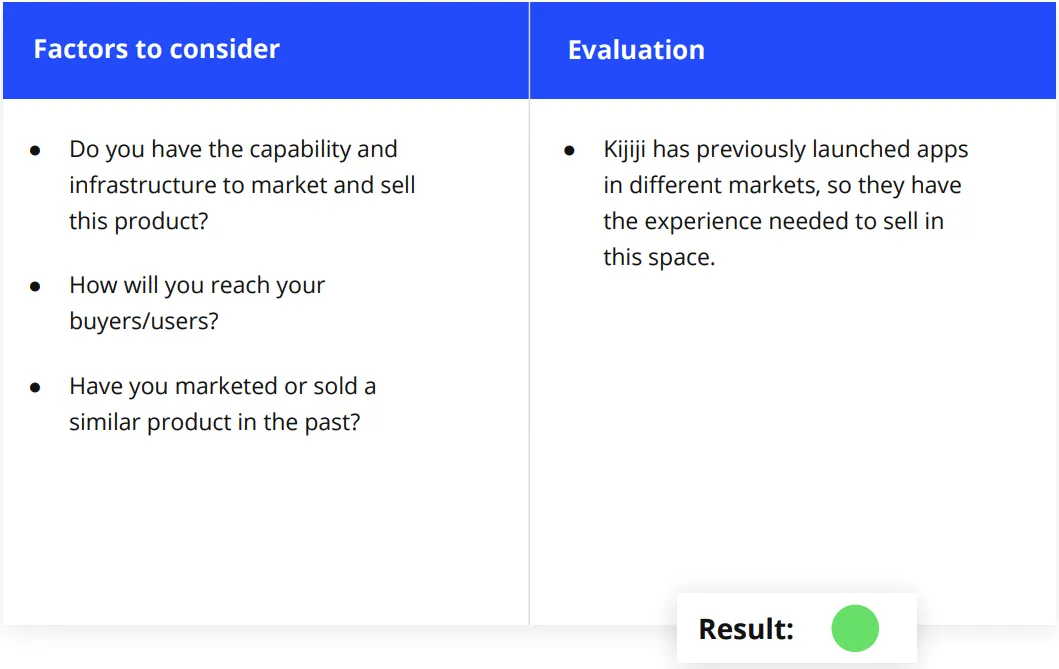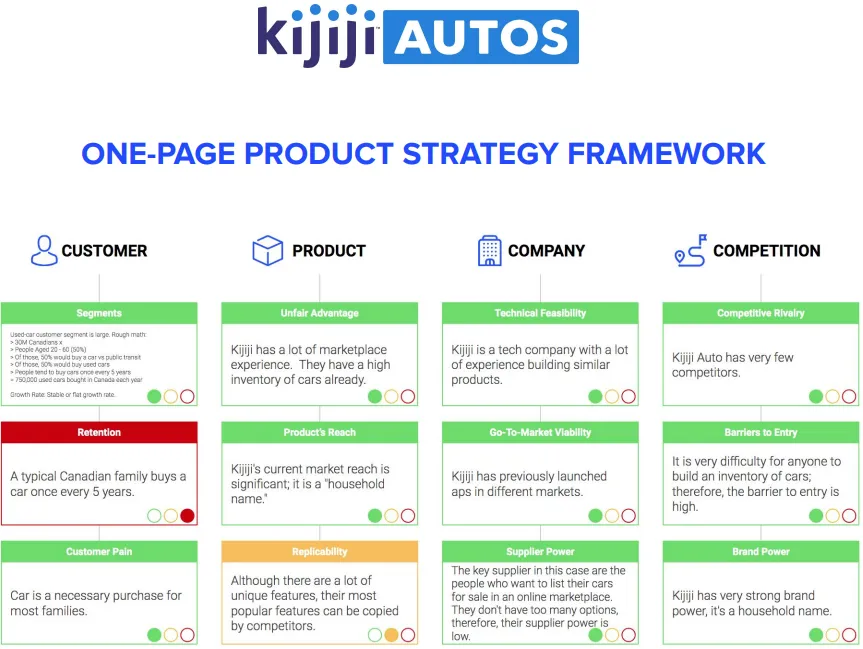
Hopefully, you can already see how answering the questions in the Product Strategy Framework can clarify the viability of your product. To illustrate how the Product Strategy Framework works, let's take a look at a real-life example: the launch of the brand new Kijiji Autos app.

Kijiji, a marketplace that allows you to buy and sell goods, launched an app in Canada that allowed users to shop for cars online. While users could already shop for cars on kijiji.com, it was mixed in with the rest of the marketplace. Kijiji Autos, on the other hand, is an app that's 100% dedicated to buying cars.
Kijiji’s hypothesis was that the experience of buying a car sucks. With their massive customer base and inventory, they set out to reimagine the experience and behavior around buying a car on a mobile device.
Let's assess Kijiji Autos with the Product Strategy Framework and see how viable it is as a product.
The focus of this element is to evaluate the size and growth of your customer segments you are targeting.
It doesn't matter how great your product is, or how fast you iterate. The market you’re in will determine a significant part of your growth.

The focus of this element is to evaluate how often users will actually use the product.
Strong retention is the prerequisite for growth for both B2B and consumer products. You need to develop a hypothesis on the organic frequency of how often the product will be used.

The focus of this element is to evaluate the magnitude of your users' pain that your product is solving for.
The bigger the pain that your product is solving, the more your customers will want your product.

The focus of this element is to evaluate the depth of your domain expertise, experience and/or connections and how well they serve you in building the product.
If you have little to no expertise, experience and/or connections, you have no significant advantage over your competitors.

This element evaluates the strength of your reach across various distribution channels.
It doesn’t matter how good your product is if no one knows you. Although you could build up reach from scratch, it requires time and effort. You need to factor in this time and effort to get a sense of your overall product growth.

This element evaluates your competitor’s ability and likelihood of copying your Product’s feature set.
Anyone of the tech giants has the capability to enter any field and replicate any feature set they choose. However, unless it fits in with their current roadmap, it's unlikely that they will do so. This element asks you to consider the likelihood and possibility that your competitors would/could replicate your feature set.

The focus of this element is to evaluate your ability to build the product with available resources.
An assessment of the technical feasibility is critical to the success of the project. If you don’t have what it takes to build the product, it will be a sure failure.

The focus of this element is to evaluate your ability to market and sell the product.
“Build it and they will come” is a misnomer. Go-to-market motions are critical to the success of your product; even more if your product is in a space with a lot of competitors.

The focus of this element is to evaluate the amount of power your suppliers have.
This will help you determine your level of reliance on your supplier.

The focus of this element is to evaluate the number and size of your competitors.
The more competition you have, the harder it will be for you to acquire customers. If you’re in a very competitive market, it’s very important for you to have clear differentiation through a focus on market positioning.

The focus of this element is to evaluate how easy it is for your competitors to enter the market.
Barriers to entry can give you an initial advantage. If the barriers to entry are high, it’ll be difficult for competitors to enter your market; therefore, you can launch with a ‘more imperfect’ product.

The focus of this element is to evaluate your level of brand awareness.
In the long-run, investments in brand can give you a significant strategic advantage because it lowers the cost of acquiring new customers (CAC).

Overall results of the Product Strategy Framework for Kijiji Auto’s Product Launch is as follows:

Prefer to keep this playbook handy for future reference, save it to your desktop, or read it offline?
Enter your email and get a copy.
Prefer to keep this playbook handy for future reference, save it to your desktop, or read it offline?
Enter your email and get a copy.
.webp)